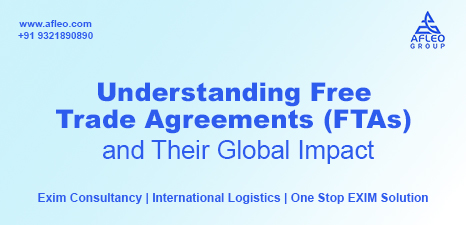In today’s interconnected global economy, Free Trade Agreements (FTAs) play a pivotal role in shaping international commerce. These treaties, signed between two or more countries, aim to promote trade by reducing or eliminating barriers like tariffs, quotas, and regulatory constraints. FTAs not only make cross-border business easier but also strengthen diplomatic ties, attract foreign investment, and stimulate economic growth. As the world becomes more interdependent, FTAs act as critical instruments for nations to compete, collaborate, and thrive on a global scale.
Defining a Free Trade Agreement (FTA): The Strategic Evolution
The concept of free trade agreements has evolved significantly over the past century – from basic tariff-cutting arrangements to sophisticated pacts that govern everything from digital commerce to intellectual property rights. Initially focused on eliminating taxes at borders, modern FTAs now reflect strategic economic partnerships, enabling countries to align their trade priorities and deepen geopolitical cooperation. These agreements are no longer just about economics; they influence environmental policies, labor standards, innovation, and global supply chain dynamics. As a result, FTAs are now key instruments in shaping not only trade flows but also international influence and regional integration.
How Free Trade Agreements Work
The procedure of the FTA is conducted through an orderly process:
- Identification of Trade Interests: Countries negotiate future trade benefits and consider the impacts of lowering trade barriers.
- Negotiation and Signing: Governments sign tariff terms, trade behavior, and terms of investment.
- Implementation Phase: Tariff-reducing measures and effective cross-border trade procedures are applied.
- Enforcement and Monitoring: Foreign institutions like the WTO and IMF ensure compliance and settle disputes.
By lessening regulatory barriers and providing fair competition, FTAs provide a secure trade climate favorable to consumers and business enterprises.
Economic Impact of Free Trade Agreements
Free trade is also responsible for shaping international economic trends via the capacity to stimulate supply and demand in foreign economies. The major advantages are:
- Economic Growth: FTA countries achieve faster GDP growth through improved trading relations and market evolution.
- Market Competition: Businesses can reach larger markets and gain access to customers incentivising innovation and new jobs.
- Lower Cost of Imports and Exports: Lower import/export trade costs lead to lower products and services prices for customers and businesses.
- Increased Foreign Direct Investment (FDI): With a good trade policy, partner nations receive more foreign investment, thereby increasing economic activity.
Different Models of Free Trade
- Mercantilism (Old Model): Protectionist economic policy in the West where countries concentrated on exports instead of imports to become wealthy.
- Comparative Advantage (New Model): A theory by which nations gain from manufacturing products where they possess a comparative advantage, resulting in efficient international trade.
Strengths and Weaknesses of Free Trade Agreement
Strengths
- Increases Economic Growth: Liberalization of trade results in more business and job opportunities.
- Reduced Prices to Consumers: Tariffs decrease and imports become cheaper.
- Increased Access to an Increased Number of Goods and Services: FTAs provide consumers with access to different quality products from across the globe.
- Technological Progress: Competition fosters technological development and industrial expansion.
[Also Read about Impact of US. Tariffs on India]
Weaknesses
- Unemployment Risk: The local industries may fail to compete with foreign industries, and this could lead to unemployment.
- Dependence on Trading Partners: Dependence on some trading partner countries can expose economies to risks.
- Environmental and Labor Issues: Weak regulation can lead to environmental harm and labor exploitation.
- Disadvantage of Forfeiting Domestic Industry Protection: Small businesses may not be competitive with an open market.
| Pros | Cons |
|---|---|
| Economic growth | Domestic industries may struggle |
| Lower tariffs | Risk of job losses in local sectors |
| Increased market access | Dependency on foreign trade |
| Innovation and competition | Possible environmental concerns |
Public Perception and Impact of FTAs
- Investor Sentiment: Financial markets usually react favorably to FTAs due to their growth and stability potential.
- Consumer Viewpoint: Even though FTAs allow more diverse products at lower prices, domestic employment security is a concern.
- Business Viewpoint: Large companies have better access to the market, while small companies find it difficult to compete with multinational corporations.
Most Comprehensive Free Trade Agreements in The World
- European Union (EU): Single market reducing trade barriers between member states.
- United States FTAs: Trade agreements such as NAFTA (now USMCA) promoting trade across North America.
- Free Trade Agreement India: India has implemented a number of FTAs, including the India-UAE CEPA and India-ASEAN FTA, enhancing its trade relationships.
India-Australia ECTA: A Modern FTA in Action
One of the most notable examples of a modern, progressive free trade agreement is the Australia-India Economic Cooperation and Trade Agreement (AI-ECTA), which came into effect in December 2022. This agreement reflects a new generation of FTAs that go beyond just tariff cuts and address broader economic integration, including services, investments, and future-focused sectors like digital trade and sustainable development.
Key Features of AI-ECTA
The AI-ECTA includes several forward-looking provisions that benefit both Indian and Australian exporters:
- Elimination of Tariffs: Australia eliminated tariffs on 100% of Indian goods exports from day one of the agreement.
- Reduced Indian Duties: India has reduced tariffs on more than 85% of Australian exports, with a plan to extend this to 90% within 10 years.
- Support for SMEs: The agreement promotes small and medium enterprises by improving transparency, cutting red tape, and encouraging bilateral collaborations.
- Streamlined Customs: Faster, more predictable customs clearance processes have been adopted to facilitate smoother trade flows.
- Professional Services & Education: Enhanced access for Australian education providers and improved recognition of qualifications support cross-border workforce mobility.
Sectoral Gains and Trade Boost
The ECTA has opened up new opportunities across sectors:
- For India: Duty-free access for textiles, pharmaceuticals, jewellery, and engineering goods into the Australian market has provided a significant competitive edge.
- For Australia: Indian tariff cuts have boosted exports of wool, wine, pulses, and premium agricultural products. Additionally, Australian educational institutions have gained wider recognition and market reach in India.
Strategic and Geopolitical Significance
The AI-ECTA is not just about economics-it carries strategic importance:
- Diversification of Trade: Both nations aim to reduce over-reliance on traditional markets and foster more resilient supply chains.
- Indo-Pacific Cooperation: The agreement strengthens India’s and Australia’s geopolitical alignment in the Indo-Pacific region.
- Pathway to CECA: AI-ECTA is an interim step toward a broader Comprehensive Economic Cooperation Agreement (CECA), which will further deepen bilateral trade.
Implications for Future FTAs
The success of AI-ECTA demonstrates how modern FTAs are evolving to meet the demands of the 21st-century economy. Its structure offers a blueprint for future agreements with key components like:
- Digital Trade Provisions
- Sustainability and Green Practices
- Improved labour mobility
- Mutual recognition of skills and qualifications
These elements align well with the growing global emphasis on inclusive, fair, and environmentally conscious trade.
Free Trade Zones: A Case Study of China
Chinese free trade zones have been set up with the intent of attracting foreign investment and the advancement of exports. Some of the most consequential examples are:
- Shanghai Free Trade Zone (FTZ): The first FTZ of China, with a focus on freeing investment.
- Guangdong FTZ: Nurturing high-tech enterprises and overseas international trade relationships.
Free Trade Areas vs. Free Trade Agreements
A free trade area differs from an FTA since it allows tariff-free trade among member states without enforcing a common external tariff on non-members. Examples include:
- Asia Pacific Trade Agreement (APTA): Free trade area among India, China, and other regional economies.
- Gulf Cooperation Council (GCC): Economic union that fosters economic cooperation among countries in the Middle East.
Arguments against Free Trade and Protectionism
- Protection of Domestic Industry: The government enforces stronger protectionist policies to protect domestic firms so that they are saved.
- Challenge for Developing Countries: In a free economy, developing countries may be behind in terms of competiveness.
- Labour and Environmental Concerns: With increased industrialisation comes pollution and the depletion of resources.
- National Security Risks: During geopolitical crises, relying on imports could pose a security risk.
Future of Global Free Trade Agreement
- New and Emerging Trade Agreements: Nations continue to negotiate FTAs in order to facilitate international economic stability and trade.
- The Rise of Digital Trade: Internet commerce and digital services are increasingly integrated into newer FTAs.
- International Trade Projections: Experts forecast the rise in regional trade blocs and digital trade agreements.
- Green Trade Practices: Future free trade agreements could contain clauses obligating ethical and environmentally sustainable trading practices.
Conclusion: The Role of FTAs in Global Trade
Free trade agreements are vital to increasing economic integration, lowering trade barriers and creating global interdependence. However, FTAs can have associated pitfalls such as disruption to the labour market, dependence upon partner nations and ethical trading practices. While world trade continues to evolve, digitalization and sustainability will feature prominently in trade pacts. FTAs, with proper policies and laws, will remain driving global economic development and growth.
How Afleo Can Help
At Afleo, we specialize in:
- Helping businesses start their export-import operations, including IES registration and policy guidance
- DGFT & Customs Consultancy Services – from Advance Authorisations to EPCG, RoDTEP, RoSCTL, and more
- End-to-end Freight Forwarding services – including Customs Clearance, Transport, and Container Bookings
Partner with us to navigate global trade with confidence, agility, and strategic foresight.
Have any doubts? Please fill the form below to get in touch with us.
[ninja_form id=12]

